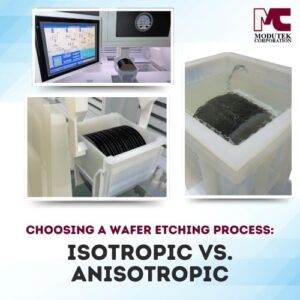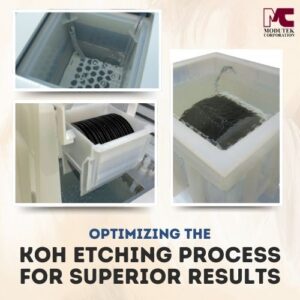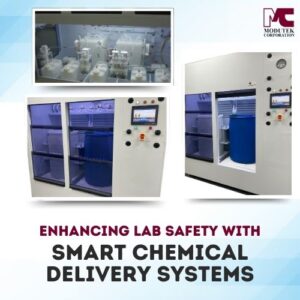![]() The microscopic structures produced by silicon wet etching can be created with a high degree of precision by using both isotropic and anisotropic processes. Isotropic etching is faster but may etch under masks to create rounded shapes. Anisotropic etching can be controlled more precisely and can produce straight sides with exact dimensions. In each case, controlling the etch bath temperature and the etchant concentration is critical for successful micro-structure creation and for repeatability for subsequent batches.
The microscopic structures produced by silicon wet etching can be created with a high degree of precision by using both isotropic and anisotropic processes. Isotropic etching is faster but may etch under masks to create rounded shapes. Anisotropic etching can be controlled more precisely and can produce straight sides with exact dimensions. In each case, controlling the etch bath temperature and the etchant concentration is critical for successful micro-structure creation and for repeatability for subsequent batches.
How Isotropic and Anisotropic Etching Differ
Silicon wafers have a mono-crystalline lattice structure that repeats in all directions but is not equally dense in all directions. Vertical planes contain a different number of silicon atoms than diagonal planes. This means that etching with certain etchants is slower in the directions with more atoms while it progresses faster in the directions with fewer atoms.
Etchants used for isotropic etching, such as hydrofluoric acid, etch at the same speed in all directions, independently of silicon atom density. For etchants used for anisotropic etching, such as potassium hydroxide (KOH), the etching speed depends on the number of silicon atoms in a crystal lattice plane and therefore depends on the direction of the different planes.
The difference in anisotropic etching speeds allows a better control of shapes etched into the silicon wafers. With a corresponding orientation of the silicon wafer, etching can be timed to produce straight or angled sides and sharp corners. Etching under masks can be reduced.
How Isotropic and Anisotropic Etching Are Used in Semiconductor Manufacturing
Isotropic etching is harder to control than anisotropic etching but it is faster. In the initial stages of silicon wafer fabrication, large features are etched into the silicon. At this stage of manufacturing, etching speed is important for facility throughput. Isotropic etching is used to quickly create these large shapes with rounded sides and corners. Although process engineers and operators have less control over the shape of the feature being etched, accurate temperature and concentration control are still important to ensure that the rounded shapes being created are the same on wafers processed in different batches.
After the large shapes are etched with an isotropic process, the micro-structures and metal paths require better control of the details. Anisotropic etching provides this control as long as the lattice structure of the silicon wafer is oriented correctly. Anisotropic KOH etching is reliable and easily controlled. It can be used to create the precise, straight-sided shapes that are required in the final semiconductor product. Accurate control of the temperature and etchant concentration is even more important for anisotropic etching because these process parameters strongly influence the etching speeds in the various directions and therefore influence the final shapes that are etched.
Modutek Teflon Tanks Support Both Isotropic and Anisotropic Etching
For silicon wet etching processes in which the etch speed is temperature dependent, Modutek’s heated Teflon tanks provide rapid heating and tight temperature control. The tanks are either recirculating or static and they can be built into any new wet bench configuration. The tanks feature 360-degree overflow filtration and uniform heating throughout the bath. The heat-up rate is 2 to 3 degrees centigrade per minute and the temperature control accuracy is plus/minus 0.5 degree centigrade. The temperature controls of these tanks are ideally suited for both isotropic and anisotropic etching.
In terms of control of etchant concentration, Modutek can provide for the injection of de-ionized water into the tanks. Because etchant concentration affects the etch speed, accurate concentration control is important for final product quality and repeatability. Modutek can analyze customer requirements, find and build custom solutions and ensure that process control is precise enough to deliver the required results, both for isotropic and for anisotropic etching.




